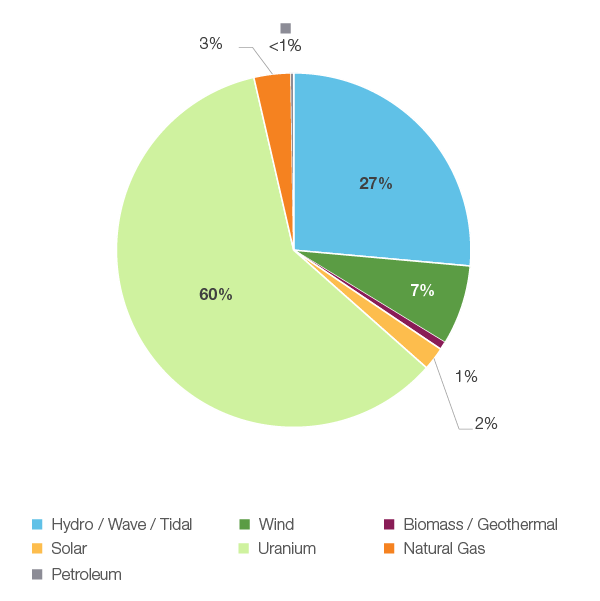Ontario
Electricity Generation and Consumption
In 2018, Ontario generated 151 terawatt hours (TW.h) of electricity. About 96% of electricity in Ontario was produced from zero carbon emitting sources: 60% from nuclear, 26% from hydroelectricity, 7% from wind, and 2% from solar. The remainder is primarily from natural gas, with some biomass. (Figure 15)
In 2017, annual electricity consumption per capita in Ontario was 9.5 MW.h.
Figure 15: Electricity Generation by Fuel Type, 2018

Source: CER - Canada’s Energy Future 2019
Description:
This pie chart shows electricity generation by source in Ontario. A total of 151.1 TW.h of electricity was generated in 2018.
Electricity Provider
Electricity is distributed by 66 local distribution companiesFootnote 1. Hydro One and Alectra are the largest electricity distribution providers in Ontario. Electricity prices are regulated and set by the Ontario Energy Board (OEB) twice a year. Prices are set in the summer (1 May to 31 October) and in the winter (1 November to 30 April).
Energy Price
The majority of Ontario residential customers fall into one of three pricing categories: time of use pricing, tiered pricing, and retail energy contract price.
The weighted average price of electricity is 8.98 cents per kilowatt hour (¢/kW.h)Footnote 2. This cost also includes the global adjustmentFootnote 3.
Time-of-Use pricing: Breaks down electricity use by on-peak, mid-peak and off-peak. The rate depends on when you use electricity. Off-peak is when demand for electricity is lowest, mid-peak is when demand is moderate,and, on-peak is when demand is highest.
Tiered pricing: Breaks down electricity cost by the amount of electricity used. In Ontario, in the summer period, residential customers on tiered pricing pay a lower rate for electricity for the first 600 kW.h they use in a month. Customers pay a higher rate for electricity used above 600 kWh in a month. In the winter period, the tier threshold goes up to 1,000 kW.h/month.
Retail Energy Contract Pricing: Electricity is purchased through a third party electricity retailer and pays the rate agreed upon by the retailer.
Transmission Charge
The transmission charge is a variable charge. The $9.26 per month, represents the average transmission charge for a residential customer that consumes 750 kW.h..
Distribution Charge
Local distribution companies also charge a rate, which covers the cost of building and maintaining overhead and underground power lines, poles, and transformer stations. On average, the charge is $4.27 cents/kWh per month.
Line Loss Adjustment
Utilities also include a line loss adjustment cost. The utility multiplies the electricity cost by an adjustment factor that accounts for those losses. They do this using an adjustment factor that is approved by the OEB. This charge is on average about $3.58 per month for a residential customer that consumes 750 kW.h.
Regulatory Charge
The regulatory charge is $3.33 per monthFootnote 4.
Ontario Rebate for Electricity Consumers Act, 2016
In 2016, Ontario passed legislation that would rebate the provincial portion of the HST from electricity bills. It came into effect 1 January 2017. As of 1 November 2019, the provincial rebate changed from 8% to 31.8% of the total bill before tax. On average, the reduction in a residential electricity bill is $15.03 per month.
Figure 16: Ontario Monthly Electricity Bill Break-down and Appliance Costs
Source: Ontario Energy Board
Description:
This interactive dashboard shows Ontario residents what it costs to run various appliances based on the different lengths of time they are operated. The data for these graphs is available.
- Date modified:
